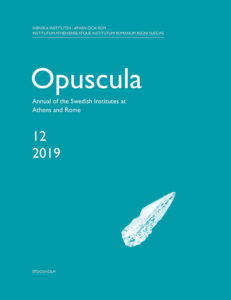 Opuscula is published by the Swedish Institutes at Athens and Rome, with the aid of a grant from the Swedish Research Council. Distributed by Eddy.se AB. View journal at ERIH PLUS. All content available with open access.
Opuscula is published by the Swedish Institutes at Athens and Rome, with the aid of a grant from the Swedish Research Council. Distributed by Eddy.se AB. View journal at ERIH PLUS. All content available with open access.
Greece and the Levant in the 10th–9th centuries BC. A view from Tel Rehov
By Amihai Mazar (The Hebrew University of Jerusalem, Israel) & Nota Kourou (University of Athens, Greece)
Abstract
Tel Rehov in the Beth Shean Valley, northern Israel, yielded 14 Greek (mainly Euboean and Attic) pottery sherds from the Late Protogeometric to Middle Geometric periods. This is the largest number of Greek sherds from these periods found at a single site in the Southern Levant in stratigraphic contexts. Since the Tel Rehov strata, well-dated by a large number of 14C dates, yielded some of the richest assemblages of finds from the 10–9th centuries BC in this region, the Greek sherds provide an opportunity to examine both their absolute dating in context and to discuss the nature of the relations between the two regions. Six of the 14 sherds were published previously (Coldstream & Mazar 2003); in the present paper, we describe the finds from Tel Rehov and other sites in the Southern Levant according to five chronological divisions, update previous discussions, and add new data and discussion based on a revised understanding of the site’s stratigraphy and interpretation of the radiocarbon data. To a large degree, the results confirm the chronological framework established by Nicolas Coldstream in 1968, although in a few cases some changes may be suggested which depend on interpretation of the radiometric data. As to the nature of the relations between Greece, in particular Euboea, and the Levant in this period, we refer to earlier ideas concerning these relations and emphasize new avenues of research raised by the discovery that copper from the Arabah Valley mines, which operated until the mid-9th century BC, served for producing ceremonial cauldrons in Greece. It is suggested that Tel Rehov played a role in such an international trading system, involving a route through Transjordan and the Jordan Valley.
Download PDF - Size: 699.72 KB - Downloads: 397 (since 2023)
Bibliographical information
Amihai Mazar & Nota Kourou, ’Greece and the Levant in the 10th–9th centuries BC. A view from Tel Rehov’, Opuscula. Annual of the Swedish Institutes at Athens and Rome (OpAthRom) 12, Stockholm 2019, 369–392. ISSN: 2000-0898. ISBN: 978-91-977799-1-3. https://doi.org/10.30549/opathrom-12-12

No Comments
Comments are closed.